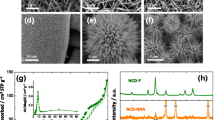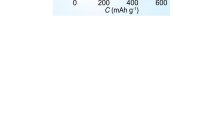Abstract
Owing to the wide range and low cost of sodium resources, sodium-ion batteries (SIBs) have received extensive attention and research. Metal sulfides with high theoretical capacity are used as promising anode materials for SIBs. This paper presents the electrochemical performance of the binder-free NiS2 nanosheet arrays grown on stainless steel (SS) substrate (NiS2/SS) using an in situ growth and sulfidation strategy as anode for sodium ion batteries. Owing to the close connection between the NiS2 nanosheet arrays and the SS current collector, the NiS2/SS anode demonstrates high rate capability with a reversible capacity of 492.5 mAh·g−1 at 5.0C rate. Such rate capability is superior to that of NiS2 nanoparticles (NiS2/CMC: 41.7 mAh·g−1 at 5.0C, NiS2/PVDF: 7.3 mAh·g−1 at 5.0C) and other Ni sulfides (100–450 mAh·g−1 at 5.0C) reported. Furthermore, the initial reversible specific capacity and Coulombic efficiency of NiS2/SS are 786.5 mAh·g−1 and 81%, respectively, demonstrating a better sodium storage ability than those of most NiS2 anodes reported for SIBs. In addition, the amorphization and conversion mechanism during the sodiation/desodiation process of NiS2 are proposed after investigation by in situ X-ray diffraction (XRD) measurements of intermediate products at successive charge/discharge stages.
Graphical abstract

摘要
由于钠资源的分布广泛和低成本, 使得钠离子电池 (SIBs) 受到了广泛的关注和研究。金属硫化物具有较高的理论容量被作为具有潜力的钠离子电池负极材料。本文报道了通过原位生长然后硫化的策略在不锈钢箔 (SS) 集流体上直接生长NiS2纳米片阵列 (NiS2/SS) 作为无粘结剂钠离子电池负极材料的储钠性能。通过原位生长的方法, 使NiS2和SS集流体之间形成紧密连接, NiS2/SS负极显示出较高的倍率性能, 在5.0C的较高电流密度下具有492.5 mAh·g-1的可逆容量, 相比于NiS2纳米颗粒 (NiS2/CMC:5.0C的电流密度具有41.7 mAh·g-1的可逆容量, NiS22/PVDF:5.0C的电流密度具有7.3 mAh·g-1的可逆容量) 和文献报道的大多数NiS2钠离子电池负极 (5.0C的电流密度具有100 – 450 mAh·g-1的可逆容量) 的倍率性能具有明显的改善。此外, NiS2/SS负极在0.1C的电流密度下具有786.5 mAh·g-1的初始可逆容量和81% 的初始库伦效率, 表明NiS2/SS负极相比于文献报道的大多数NiS2具有更优异的储钠性能。进一步, 通过对充/放电过程的中间产物进行原位X射线衍射 (XRD) 测试, 研究了NiS2的嵌/脱钠过程中的非晶化和转化机理。









Similar content being viewed by others
References
Tarascon JM, Armand M. Issues and challenges facing rechargeable lithium batteries. Nature. 2001;414(6861):359.
Goodenough JB, Kim Y. Challenges for rechargeable Li batteries. Chem Mater. 2010;22(3):587.
Cai ZL, Peng ZL, Wang MQ, Wu JY, Fan HS, Zhang YF. High-pseudocapacitance of porous and square NiO@NC nanosheets for high-performance lithium-ion batteries. Rare Met. 2021;40(6):1451.
Hwang JY, Myung ST, Sun YK. Sodium-ion batteries: present and future. Chem Soc Rev. 2017;46(12):3529.
Zhang WC, Liu YJ, Guo ZP. Approaching high-performance potassium-ion batteries via advanced design strategies and engineering. Sci Adv. 2019. https://doi.org/10.1126/sciadv.aav7412.
Qi SH, Deng JW, Zhang WC, Feng YZ, Ma JM. Recent advances in alloy-based anode materials for potassium ion batteries. Rare Met. 2020;39(9):970.
Pan HL, Hu YS, Chen LQ. Room-temperature stationary sodium-ion batteries for large-scale electric energy storage. Energ Environ Sci. 2013;6(8):2338.
Yabuuchi N, Kubota K, Dahbi M, Komaba S. Research development on sodium-ion batteries. Chem Rev. 2014;114(23):11636.
Yang Y, Wei WF. Electrochemical mechanism of high Na-content P2-type layered oxides for sodium-ion batteries. Rare Met. 2020;39(4):332.
Deng XL, Zou KY, Momen R, Cai P, Chen J, Hou HS, Zou GQ, Ji XB. High content anion (S/Se/P) doping assisted by defect engineering with fast charge transfer kinetics for high-performance sodium ion capacitors. Sci Bull. 2021;66(18):1858.
Zou KY, Song ZR, Gao X, Liu HQ, Luo Z, Chen J, Deng XL, Chen LB, Zou GQ, Hou HS, Ji XB. Molecularly compensated pre-metallation strategy for metal-ion batteries and capacitors. Angew Chem Int Ed. 2021;60(31):17070.
Sui YL, Zhou J, Wang XW, Wu L, Zhong SK, Li YG. Recent advances in black-phosphorus-based materials for electrochemical energy storage. Mater Today. 2021. https://doi.org/10.1016/j.mattod.2020.09.005.
Zhang BA, Ghimbeu CM, Laberty C, Vix-Guterl C, Tarascon JM. Correlation between microstructure and Na storage behavior in hard carbon. Adv Energy Mater. 2016;6(1):1501588.
Sui YL, Hao YY, Zhang XP, Li JP, Wen GY, Zhong SK, Zhang ZW, Wu L. Improved electrochemical properties of vanadium substituted Na0.67Fe0.5Mn0.5O2 cathode material for sodium-ion batteries. Ceram Int. 2021;47(4):5227.
Yu P, Tang W, Wu FF, Zhang C, Luo HY, Liu H, Wang ZG. Recent progress in plant-derived hard carbon anode materials for sodium-ion batteries: a review. Rare Met. 2020;39(9):1019.
Zhou SY, Jin XZ, Zhu SM, Luo Q, Qiu ZW, Wu AM, Huang H. S-O bond chemically constrained NiS2/rGO nanocomposite with enhanced Na-ion storage capacity. Chin Chem Lett. 2020;31(9):2353.
Zhu KJ, Liu G, Wang YJ, Liu J, Li ST, Yang LY, Liu SL, Wang H, Xie T. Metal-organic frameworks derived novel hierarchical durian-like nickel sulfide (NiS2) as an anode material for high-performance sodium-ion batteries. Mater Lett. 2017. https://doi.org/10.1016/j.matlet.2017.03.087.
Wang TS, Hu P, Zhang CJ, Du HP, Zhang ZH, Wang XG, Chen SG, Xiong JW, Cui GL. Nickel disulfide-graphene nanosheets composites with improved electrochemical performance for sodium ion battery. Acs Appl Mater Inter. 2016;8(12):7811.
Chen Q, Sun S, Zhai T, Yang M, Zhao XY, Xia H. Yolk-shell NiS2 nanoparticle-embedded carbon fibers for flexible fiber-shaped sodium battery. Adv Energy Mater. 2018;8(19):1800054.
Sun RM, Liu SJ, Wei QL, Sheng JZ, Zhu SH, An QY, Mai LQ. Mesoporous NiS2 nanospheres anode with pseudocapacitance for high-rate and long-life sodium-ion battery. Small. 2017;13(39):1701744.
Zhao FP, Gong QF, Traynor B, Zhang D, Li JJ, Ye HL, Chen FJ, Han N, Wang YY, Sun XH, Li YG. Stabilizing nickel sulfide nanoparticles with an ultrathin carbon layer for improved cycling performance in sodium ion batteries. Nano Res. 2016;9(10):3162.
Pan Q, Xie J, Zhu TJ, Cao GS, Zhao XB, Zhang SC. Reduced graphene oxide-induced recrystallization of nis nanorods to nanosheets and the improved Na-storage properties. Inorg Chem. 2014;53(7):3511.
Pi WB, Mei T, Li J, Wang JY, Li JH, Wang XB. Durian-like NiS2@rGO nanocomposites and their enhanced rate performance. Chem Eng J. 2018. https://doi.org/10.1016/j.cej.2017.10.142.
Yang DD, Zhao M, Zhang RD, Zhang Y, Yang CC, Jiang Q. NiS2 nanoparticles anchored on open carbon nanohelmets as an advanced anode for lithium-ion batteries. Nanoscale Adv. 2020;2(1):512.
Abdel–Hamid AA, Yang XF, Yang JH, Chen XJ, Ying JY. Graphene-wrapped nickel sulfide nanoprisms with improved performance for Li-ion battery anodes and supercapacitors. Nano Energy. 2016. https://doi.org/10.1016/j.nanoen.2016.05.046.
Li JB, Li JL, Yan D, Hou SJ, Xu XT, Lu T, Yao YF, Mai WJ, Pan LK. Design of pomegranate-like clusters with NiS2 nanoparticles anchored on nitrogen-doped porous carbon for improved sodium ion storage performance. J Mater Chem A. 2018;6(15):6595.
Go DY, Park J, Noh PJ, Cho GB, Ryu HS, Nam TH, Ahn HJ, Kim KW. Electrochemical properties of monolithic nickel sulfide electrodes for use in sodium batteries. Mater Res Bull. 2014. https://doi.org/10.1016/j.materresbull.2014.05.008.
Zou F, Manthiram A. A review of the design of advanced binders for high-performance batteries. Adv Energy Mater. 2020;10(45):2002508.
Zou KY, Cai P, Wang BW, Liu C, Li JY, Qiu TY, Zou GQ, Hou HS, Ji XB. Insights into enhanced capacitive behavior of carbon cathode for lithium ion capacitors: the coupling of pore size and graphitization engineering. Nano-Micro Lett. 2020;12(1):121.
Fan MP, Yu HY, Chen Y. High-capacity sodium ion battery anodes based on CuO nanosheets and carboxymethyl cellulose binder. Mater Technol. 2017;32(10):598.
Sun S, He DL, Li P, Liu Y, Wan Q, Tan QW, Liu ZW, An FQ, Gong GX, Qu XH. Improved adhesion of cross-linked binder and SiO2-coating enhances structural and cyclic stability of silicon electrodes for lithium-ion batteries. J Power Sources. 2020. https://doi.org/10.1016/j.jpowsour.2020.227907.
Jiao XX, Yin JQ, Xu XY, Wang JL, Liu YY, Xiong SZ, Zhang QL, Song JX. Highly energy-dissipative, fast self-healing binder for stable Si anode in lithium-ion batteries. Adv Funct Mater. 2020;31(3):2005699.
Xiao W, Sun Q, Banis MN, Wang BQ, Li WH, Li MS, Lushington A, Li RY, Li XF, Sham TK, Sun XL. Understanding the critical role of binders in phosphorus/carbon anode for sodium-ion batteries through unexpected mechanism. Adv Funct Mater. 2020;30(32):2000060.
Xue L, Savilov SV, Lunin VV, Xia H. Self-standing porous LiCoO2 nanosheet arrays as 3d cathodes for flexible Li-ion batteries. Adv Funct Mater. 2018;28(7):1705836.
Wang HW, Fu JZ, Wang C, Wang JY, Yang AK, Li CC, Sun QF, Cui Y, Li HQ. A binder-free high silicon content flexible anode for Li-ion batteries. Energ Environ Sci. 2020;13(3):848.
Ge XL, Li ZQ, Yin LW. Metal-organic frameworks derived porous core/shellcop@C polyhedrons anchored on 3D reduced graphene oxide networks as anode for sodium- ion battery. Nano Energy. 2017. https://doi.org/10.1016/j.nanoen.2016.11.055.
Yan RY, Josef E, Huang HJ, Leus K, Niederberger M, Hofmann JP, Walczak R, Antonietti M, Oschtz M. Understanding the charge storage mechanism to achieve high capacity and fast ion storage in sodium-ion capacitor anodes by using electrospun nitrogen-doped carbon fibers. Adv Funct Mater. 2019;29(26):1902858.
Xie D, Xia XH, Zhong Y, Wang YD, Wang DH, Wang XL, Tu JP. Exploring advanced sandwiched arrays by vertical graphene and N-doped carbon for enhanced sodium storage. Adv Energy Mater. 2017;7(3):1601804.
Peng PP, Wu YR, Li XZ, Zhang JH, Li YW, Cui P, Yi TF. Toward superior lithium/sodium storage performance: design and construction of novel TiO2-based anode materials. Rare Met. 2021;40(11):3049.
Chao DL, Zhu CR, Xia XH, Liu JL, Zhang X, Wang J, Liang P, Lin JY, Zhang H, Shen ZX, Fan HJ. Graphene quantum dots coated VO2 arrays for highly durable electrodes for Li and Na ion batteries. Nano Lett. 2015;15(1):565.
Qin BS, Zhang H, Diemant T, Dou XW, Geiger D, Behm RJ, Kaiser U, Varzi A, Passerini S. Exploring SnS nanoparticles interpenetrated with high concentration nitrogen-doped-carbon as anodes for sodium ion batteries. Electrochim Acta. 2019. https://doi.org/10.1016/j.electacta.2018.11.112.
Durai L, Moorthy B, Thomas CI, Kim DK, Bharathi KK. Electrochemical properties of BiFeO3 nanoparticles: anode material for sodium-ion battery application. Mat Sci Semicon Proc. 2017. https://doi.org/10.1016/j.mssp.2017.06.003.
Tao HW, Zhou M, Wang RX, Wang KL, Cheng SJ, Jiang K. TiS2 as an advanced conversion electrode for sodium-ion batteries with ultra-high capacity and long-cycle life. Adv Sci. 2018;5(11):1801021.
Adegbemiga YB, Ullah N, Xie M, Hussain S, Oluigbo CJ, Yaseen W, Kumar AJ, Xu YG, Xie JM. Ni3Fe nanoparticles enclosed by B-doped carbon for efficient bifunctional performances of oxygen and hydrogen evolution reactions. J Alloy Compd. 2020. https://doi.org/10.1016/j.jallcom.2020.155267.
Xin S, Yin YX, Guo YG, Wan LJ. A high-energy room-temperature sodium-sulfur battery. Adv Mater. 2014;26(8):1261.
Acknowledgements
This study was financially supported by the National Natural Science Foundation of China (No. 21673051), the Department of Science and Technology of Guangdong Province (No. 2019A050510043) and the Department of Science and Technology of Zhuhai City, China (No. ZH22017001200059PWC).
Author information
Authors and Affiliations
Corresponding authors
Ethics declarations
Conflict of interests
The authors declare that they have no conflict of interest.
Rights and permissions
About this article
Cite this article
Fan, MP., Chen, YC., Chen, YM. et al. NiS2 nanosheet arrays on stainless steel foil as binder-free anode for high-power sodium-ion batteries. Rare Met. 41, 1294–1303 (2022). https://doi.org/10.1007/s12598-021-01890-2
Received:
Revised:
Accepted:
Published:
Issue Date:
DOI: https://doi.org/10.1007/s12598-021-01890-2




